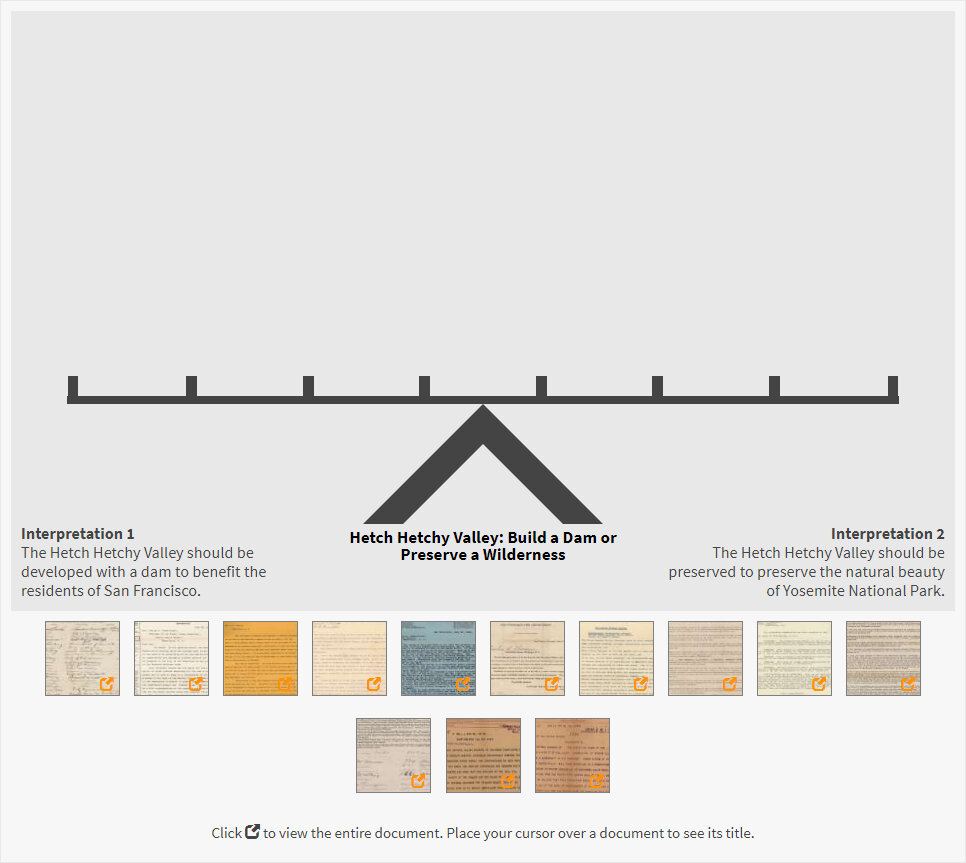In this activity, students will analyze documents related to the environmental debate about developing a dam for a steady water supply for the residents of San Francisco in the Hetch Hetchy Valley. They will analyze petitions, resolutions, and telegrams sent to the United States Senate. Students will study the Hetch Hetchy debate with primary sources from the records of Congress.
From 1908-1913, Congress debated legislation to supply the city of San Francisco with water by damming the Hetch Hetchy Valley. As it debated this legislation, Congress negotiated the fate of a federally protected valley located in Yosemite National Park – asking should the dam be built or the valley preserved?
Suggested Teaching Instructions
This activity can be used to explore the topic of environmental protection and economic development with students. This activity can be completed in class, in small groups, in pairs, individually, or assigned as homework. Designed for students in grades 7–12. The approximate time needed is 80 minutes.
To have students start thinking about the tensions between environmental protection and economic development, provide a hypothetical situation that relates to the Hetch Hetchy Valley case study.
For example, tell students that due to recent population growth in their area, a new school will have to be built to accommodate the growing number of students in the next 5 years. The only available land for the school is in the nearby nature preserve controlled by the state. While this land cannot be used for private development (i.e. a business, residential, etc), it can be used for government purposes like a school.
Give students several minutes to think about the issue: Should a school be built on preserved lands? Do a think/pair/share related to the issue. Ask students to brainstorm at least 1-2 reasons in support of their opinion. Discuss their opinions.
After discussing this hypothetical issue, segue to the issue of the Hetch Hetchy Valley and San Francisco as a historical case study of the tension between development and preservation. Tell students they will be exploring the issue through petitions, resolutions, and telegrams sent to the United States Senate in favor and against damming the Hetch Hetchy Valley.
Share the following historical information:
Between 1908 and 1913, Congress debated whether to make a water resource available or preserve a wilderness when the growing city of San Francisco, California, proposed building a dam in the Hetch Hetchy Valley to provide a steady water supply. The Hetch Hetchy Valley was within Yosemite National Park and protected by the Federal Government, leaving it up to Congress to decide the valley’s fate. National opinion divided between giving San Francisco the right to dam the valley and preserving the valley from development.
At the heart of the debate was the conflict between conservationists, who held that the environment should be used in a conscientious manner to benefit society, and preservationists, who believed that nature should be protected, saved from human interference. Siding with the conservationists, San Francisco citizens argued that the reservoir was necessary for the health of their city. On the other side, preservationists, led by John Muir, argued that Congress should protect the Hetch Hetchy Valley from destruction. Muir and his allies believed that nature should be enjoyed for its beauty, and not merely used for its resources.
Hundreds of individuals and organizations from across the country submitted petitions to Congress regarding the valley. These petitions, some of which are included below, bear witness to the birth of environmental activism as citizens weighed in, expressing multiple opinions about the proper use of National Park land and the relationship between local interests and national values.
Ask students to think about and consider the issues at play:
- The valley belongs to all the people as a public playground. The valley is a scenic resource to the nation as an unspoiled wonder.
- The valley is a water resource that San Francisco has a legal right to develop. The valley should be dammed as a source of pure drinking water essential to public health in San Francisco.
Encourage students to keep these questions and their first reactions in mind as they complete this activity and analyze documents from the past. Open the activity and select one of the documents. Model careful
document analysis, ending with the question "
Should the Hetch Hetchy Valley be developed or preserved?" based on this document.
Demonstrate how the scale works and ask students to place the document they just examined on the scale according to the interpretation it best supports: the Hetch Hetchy Valley should be developed with a dam to benefit the residents of San Francisco OR the Hetch Hetchy Valley should be preserved to preserve the natural beauty of Yosemite National Park.
Explain to the students that they will need to place each textual record on the scale based on careful document analysis. After students complete the activity, they should click on “When You're Done” and answer the questions listed. Conduct a class discussion based on the students’ answers from the document analysis.
Share the following context:
In the end, Congress passed legislation that enabled the creation of a dam in the Hetch Hetchy Valley. President Woodrow Wilson signed the bill into law on December 19, 1913. Although the preservationists lost this battle, the damming of the Hetch Hetchy Valley raised public awareness about the importance of preserving nature, and helped justify the creation of the National Park Service in 1916.
This DocsTeach activity was adapted from Hetch Hetchy: Congress and the Environment from the Center for Legislative Archives. 




